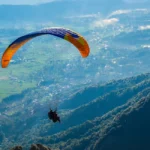Located in the pristine Dhauladhar ranges of Himachal Pradesh, Bir Billing is not only the paragliding hub of India but also a breathtaking location. While paraglider enthusiasts will be satisifed by the challenging terrains from above, culture enthusiasts will fall in love with the local traditions, rich spirituality, and colorful festivals associated with the locals. Bir Billing uniquely infuses Tibetan culture, Himachali traditions, and spiritual roots that provide a different experience to travelers looking to explore India’s amazing multicultural heritage.
A Unique Cultural Landscape: Tibetan Meets Himachali
Thanks to its multi-cultural surroundings, Bir Billing is certainly one of a kind. The mud houses, wooden carvings, and folk traditions showcase the warmer side of the Himachali villages. Meanwhile, the soaring Tibetan prayer flags and calm Buddhist chants introduce Bir Billing as warm, peaceful, and meditative.
Bir is famous for its monasteries, which are a must-see for traveling tourists as well as dedicated followers of Buddhism. The cultural identity of the town was greatly influenced with the settlement of Tibetan refugees in the 1960s. These people brought with them centuries-old traditions of Buddhism along with a system of monastic education and strong self-discipline rooted in spirituality.
Major Festivals Celebrated in Bir Billing
Let us research the major festivals the place contains which serves as a reminder for the tourists who visit the place to indulge themselves in a truly constructive celebration.
1. Losar Festival (Tibetan New Year)
- When: February or early March (varies by lunar calendar)
- Where: Palpung Sherab Ling Monastery, Chokling Monastery, and surrounding Tibetan settlements
- Highlights: Masked Cham dances, creation of butter sculptures, lighting of butter lamps, family feasts, and ceremonial prayers.
Bir is renowned for housing the most spectacular of Tibetans festivals -the Losar festival. The festival celebrates the end of a year and welcomes a new one. As any festival, losar is celebrated with great fervor throughout the country. Preparations start weeks before during which houses are cleaned, special food is prepared, and altars are decorated. Monks perform ceremonial dances which are referred to as “Cham dances” in specially designed and engraved masks which represent spirits and deities. These dances are not only eye-capturing but they are also very important for the spirit of the person who witnesses it. It is believed to get rid of mischief sails and purify the place.
2. Tsechu Festival
- When: Varies, typically held during summer or autumn
- Where: Major monasteries in the region
- Highlights: Cham dances, storytelling of Padmasambhava’s life, community gatherings, spiritual teachings
This festival celebrates the great Buddhist master Guru Padmasambhava. Tsechu attracts devotees from nearby villages because of the sacred masked dances performed during the festival that recount the life of Guru Padmasambhava, who is responsible for the wide-spread Buddhism in the Himalayan region. For travelers, this is an unparalleled opportunity to witness Buddhist culture in its pure form.
3. Shivratri Mahotsav
- When: February or March
- Where: Baijnath Temple, about 20 km from Bir
- Highlights: Traditional Himachali rituals, folk music and dance, local cuisine stalls, temple processions.
Bir Billing is predominantly a Tibetan-Buddhist town, but is located next to the ancient town of Baijnath, which’s home to one of the oldest Shiva temples in North India. This festival combines spiritual rituals with local cultural performances where villagers dress in flamboyant, traditional attire and perform the famous Himachali “Nati” dance and prepare offerings for Lord Shiva.
4. International Paragliding Festival
- When: October to November
- Where: Billing take-off point and Bir landing site
- Highlights: Paragliding competitions, adventure expos, cultural nights, local handicraft and food stalls
Although not an official festival, the International Paragliding Festival has become one of the prominent parasailing festivals of Bir. All of the world’s pilots compete, while local music, dance, and festivals amuse the people during the evenings. This festival captures the modern soul of Bir, the place where adventure and community celebration intertwine.
5. Sazo Festival
- When: Mid-January
- Where: Himachali villages around Bir
- Highlights: Fire rituals, offerings to local deities, storytelling, traditional cuisine
Sazo is an ancient Himachal festival which observes village deities going to the celestial realms during this duration. People are always seen constructing sacred bonfires, cooking traditional meals, and praying for safety and well-being. The vibe is calm, deep and enlightening, showcasing the pre-buddhist animistic faiths still present in the region.
Local Culture and Daily Life
Monastic Life
Bir is home to several prominent monasteries:
- Palpung Sherab Ling Monastery: The seat of the 12th Tai Situ Rinpoche, known for its grand architecture and spiritual ambiance.
- Chokling Monastery: Offers Buddhist teachings, meditation sessions, and a serene environment.
- Dzongsar Institute: A renowned center for higher Buddhist studies.
Daily monastic life involves chanting, studying ancient scriptures, meditating, and maintaining the monasteries. Visitors can often attend ceremonies or even take short retreats to experience spiritual discipline.
Folk Traditions
In the surrounding villages, Himachali traditions are alive and well:
- Nati Dance: Recognized as one of the oldest dance forms in the country, Nati is performed during festivals, weddings, and village gatherings.
- Traditional Attire: Men wear woolen coats and turbans, while women are often seen in colorful “Pattu” shawls and silver jewelry.
- Craftsmanship: Locals are skilled in weaving, carpentry, and handloom production. Handmade woolen products and bamboo crafts are popular among tourists.
Cuisine
Bir Billing offers a delightful mix of Tibetan and Himachali flavors:
- Tibetan Dishes: Momos, Thukpa, Tingmo (steamed bread), and butter tea
- Himachali Specialties: Rajma-chawal, Siddu (stuffed wheat bread), Bhey (lotus stem curry), and Madra
Most homestays and cafes in Bir serve organic, home-cooked meals, often using locally grown ingredients.
Traveler Tips: Immerse Yourself in Local Culture
- Stay in Homestays: This is the best way to experience daily life and local hospitality.
- Attend a Monastery Ceremony: Respectful visitors are often welcome during prayer sessions.
- Visit During Festivals: Plan your trip around Losar or the Paragliding Festival for a richer experience.
- Take a Cultural Walk: Walk through Tibetan colonies, local markets, and ancient temples.
- Join a Retreat: Whether spiritual or artistic, many programs are open to visitors.
Final Thoughts
Bir Billing perfectly encapsulates a place where the vastness of the sky seamlessly intertwines with the tranquility of a soul. Although paragliding makes Bir popular worldwide, what captivates one’s heart are the people, their tales, and the rich heritage that these folks bolster. From Nati’s fervent rhythms to the quiet thanksgiving of the monks, colorful prayer flags to Himachali hearths aglow with fire — Bir is a living legacy of multicultural convergence.
Regardless of whether you wish to escape into the wild or enjoy the serenity of nature, do not miss the vibrant culture and different local festivals of Bir Billing. Here is not only the beauty of Himachal but the spirit of India.



